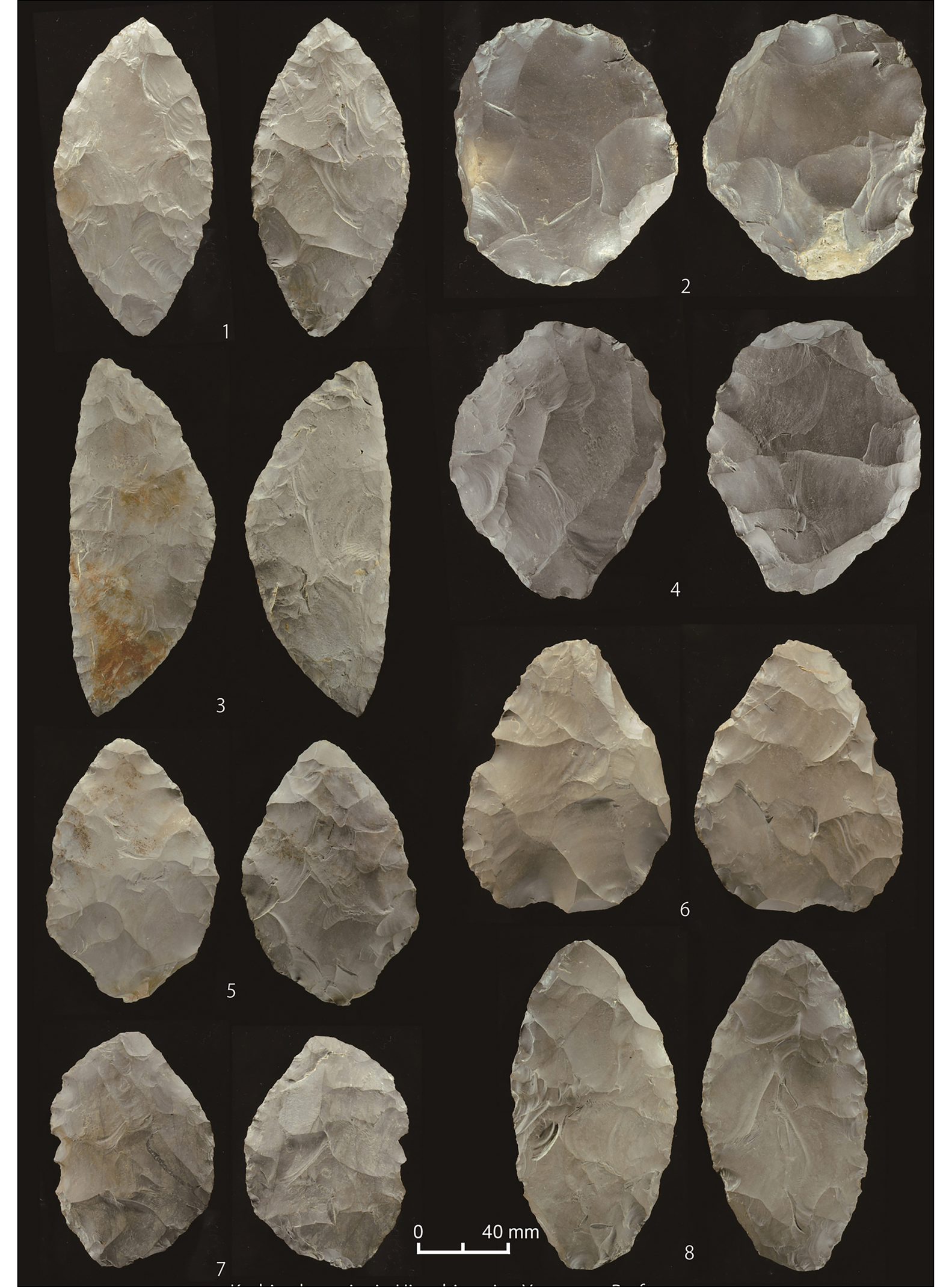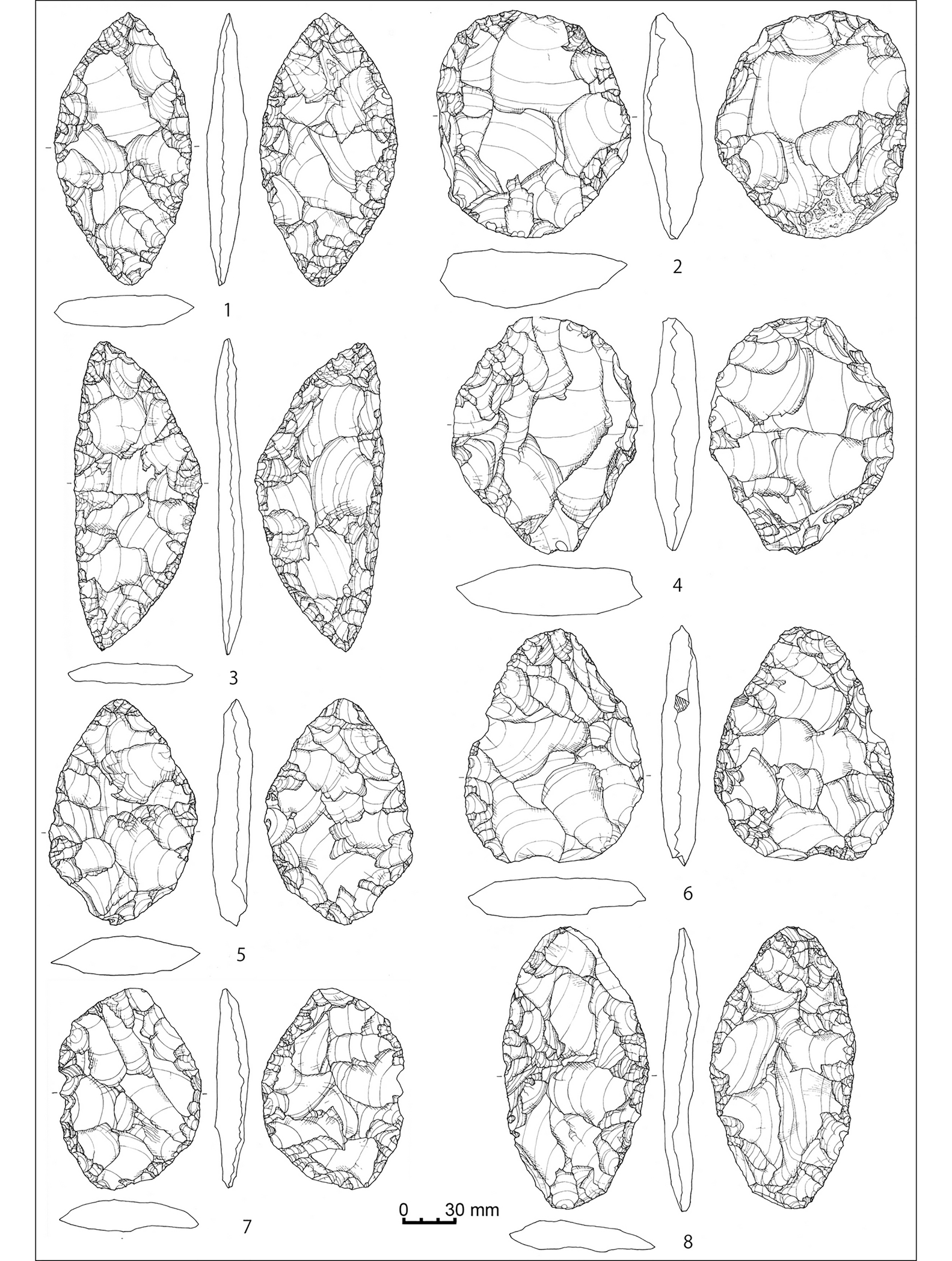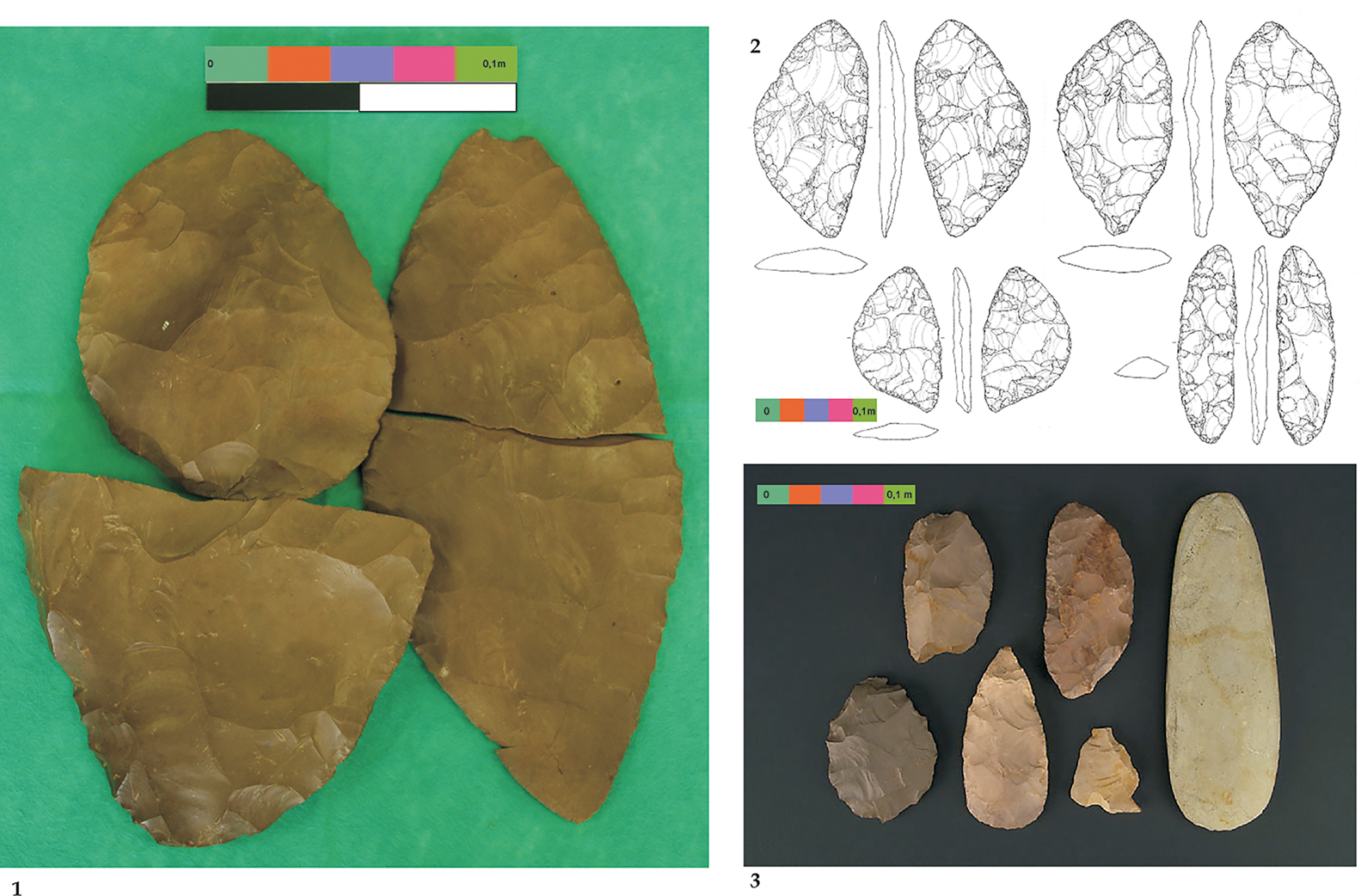Introduction
In 2016, eight bifacial lithic artefacts were found at Kashiwabara in the Tohoku region of Japan. The artefacts were discovered by a farmer within a 2 × 2m area at a depth of around 2m (Inamura Reference Inamura2016) (Figure 1). In the spring of 2018, one of the authors (Kanomata) completed a preliminary technological analysis of the assemblage and prepared detailed photographs and drawings of what became known as the ‘Kashiwabara biface complex’ (KBC) (Figures 2–3). In July 2018 archaeological excavation was undertaken at Kashiwabara by the Laboratory of Archaeology, Tohoku University. In total, seven test-pits were excavated (TP01-07), comprising a total area of 19m2. Excavations were designed to investigate the geological and archaeological context of the lithics. An additional site visit was undertaken by the authors in September 2019 to assess the landscape for further finds after the harvest; no other excavation was undertaken at this time and no surface finds were recovered.

Figure 1. Map of the Tohoku Region, Japan, showing locations with large bifaces: 1) Kashiwabara; 2) Nogawa; 3) Iwase; 4) Sendaiuchimae (illustration by A. Tabarev; template available here: https://japandeluxetours.com/destinations/region-tohoku).

Figure 2. Kashiwabara biface complex artefacts 1–8 (photograph: Y. Kanomata).

Figure 3. Illustration of Kashiwabara biface complex artefacts 1–8 (illustrated by Y. Kanomata).
Kashiwabara biface complex
The stratigraphy of the test-pits was typical of an alluvial terrace, comprising multiple layers of sand and silt with gravel inclusions. The pit profiles had no tephra horizons that could be used for radiometric dating (Figure 4). The discovery of the KBC assemblage in an area with no other archaeological material and no obvious occupation levels, together with the unbroken nature of the artefacts, suggests that they were probably deliberately deposited together in one event and may represent a cache. The artefacts did not exhibit any evidence of water damage, ruling out their deposition by the action of a stream or watercourse. This deposit was probably not connected with a living area or workshop; rather, the location of the deposit, between minor tributaries of the Mogami River, is an ideal temporary storage location on a direct route between the source of a raw material (shale) and seasonal settlements.

Figure 4. South-facing section of test-pit 5 (TP05): 1) photograph with stratigraphy overlaid; 2) section drawing showing contexts: blue = sand; brown = sand with gravel; yellow = silt (photograph and illustration by Y. Kanomata & A. Tabarev).
The dimensions of all artefacts are recorded in Table 1 and the preparation for edge retouch and platforms for flake removals are illustrated by colour-coded diagrams shown in Figure 5. All bifaces in the assemblage were made from brown silicified shale sourced from an outcrop 3km north-west of Kashiwabara and were manufactured by direct percussion. They demonstrate different reduction sequences, and can be divided into bifacial cores for flake blanks (artefacts 2 and 4–8) and preforms for tools (artefacts 1 and 3). Given the techniques evidently used to manufacture the bifacial artefacts, and the sequence of flake removals on the bifacial cores, it is reasonable to suggest that all eight artefacts are the work of a single knapper. In terms of the use of the artefacts, the bifaces are not especially large for their type, neither are they made from exotic material; this suggests that the tools were probably utilitarian rather than ritual.

Figure 5. Manufacture techniques evident on the KBC lithics: 1) reduction: red = edge preparation; green = platform preparation; yellow = flake negatives. 2) Illustration showing length of artefacts (illustrations by Y. Kanomata & A. Tabarev).
Table 1. KBC artefact measurements.

Kashiwabara is not the first example of a multiple bifacial tool deposit; these are also recorded at several Incipient Jomon sites in the Tohoku Region (Figure 1: 2 & 4). At Nogawa site (Miyagi Prefecture, 30km east of Kashiwabara), for example, bifaces (including one large example measuring 225 × 101mm) were placed in one of three cache-pits accompanied by other lithics; at the Iwase site (Akita Prefecture, 100km north of Kashiwabara), leaf-shaped bifaces with numerous refits were found in three lithic clusters, and at Sendaiuchimae (Fukushima Prefecture, 82km south of Kashiwabara) four bifaces were cached with one axe and one large flake (Figure 6) (Kanomata Reference Kanomata2008).

Figure 6. Other biface caches: 1) Nogawa; 2) Iwase; 3) Sendaiuchimae (photographs and illustration by Y. Kanomata & A. Tabarev).
While general caching of partly finished lithics (preforms, cores and flakes) has been described for several Late Palaeolithic sites in continental Eastern Eurasia (Tabarev et al. Reference Tabarev, Gillam, Kanomata and Gunchinsuren2013), it is interesting to note that all of the Japanese bifacial caches demonstrate much closer affinity with the Palaeoindian caches (Clovis in particular) in North America (Kilby & Huckell Reference Kilby, Huckell, Graf, Goebel and Waters2013). Finds at Kashiwabara provide further support for the argument that preform-tool-caching strategies were not unique to the North American Palaeoindians, but have broader North-east Asian analogies among mobile hunters.
Conclusion
Taking into consideration the morphological and technological characteristics of the artefacts, and their context, and comparing them with the North American analogues, we conclude that the KBC can be interpreted as an example of caching behaviour that can be seen as part of a wider adaptive strategy among Incipient Jomon foragers in the Tohoku Region, Japan (c. 15–11 500 cal BP).
Acknowledgements
This research was funded by the Russian Scientific Foundation (Project #19-18-00003) and the Japan Society for the Promotion of Science (Project # 16K03149). We would like to thank K. Motoki and K. Inamura, for access to the site and for the initial information about the discovery.










